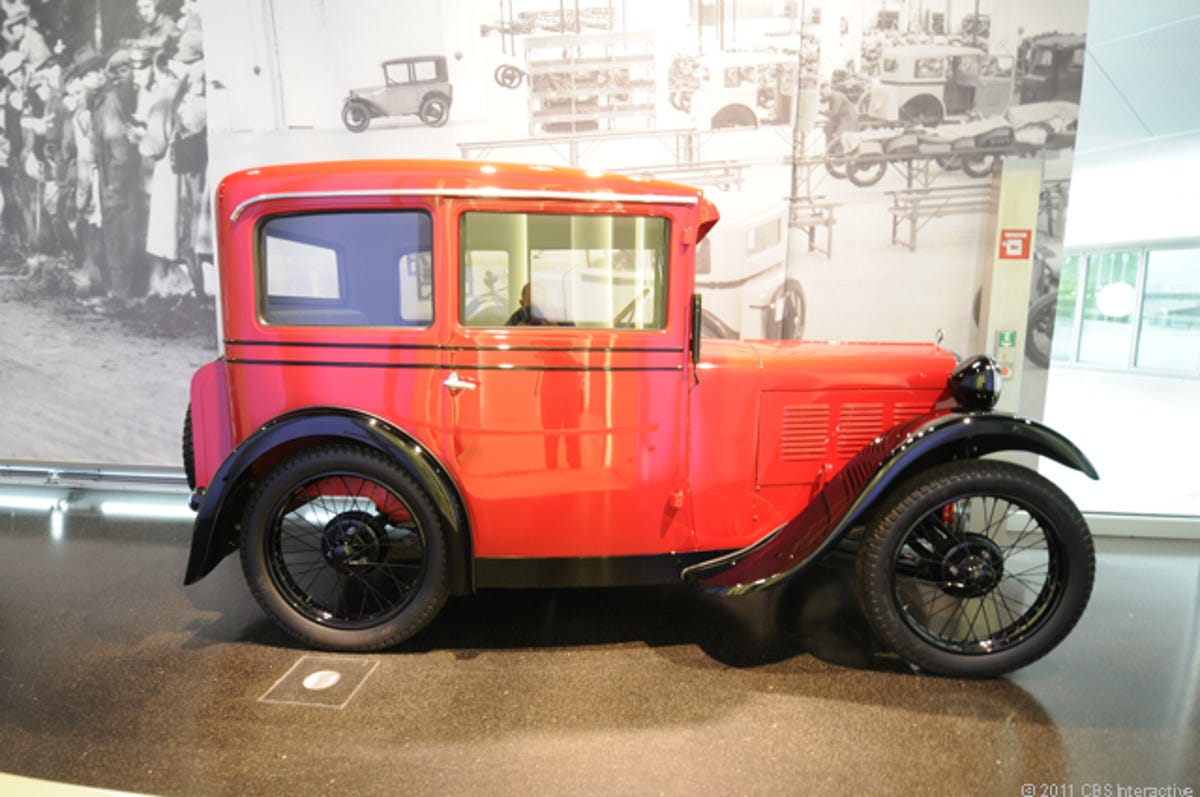The history of BMW's 'ultimate driving machine' (photos)
Road Trip 2011: A visit to the BMW Museum in Munich, Germany, offers a peek at the many decades that the company has made some of the finest cars in the world.

First BMW Car
MUNICH, Germany--For many BMW fans, this large Bavarian town--home to the company's headquarters and the place where many of its cars are made--is the center of the universe. And it's also where Bavarian Motor Works showcases what may be the most important and/or beautiful cars, motorcycles, and engines in its history: The BMW Museum.
First opened in 1973, it was enlarged and redesigned in 2008 as part of a larger brand expansion that also includes the adjacent production plant and the famous "BMW Welt," a massive glass masterpiece where anyone can come and see just about everything the manufacturer is up to today.
Inside the museum, BMW lovingly lays out its many decades of automotive craftsmanship. For example, this is the first BMW model of car, a 3/15 PS, made from 1929 to 1932. "Although basically a British Austin Seven built under license," a sign at the museum reads, "BMW's engineers were able to incorporate many improvements such as four-wheel brakes, a larger all-steal body, and a higher standard of interior equipment and trim."
Spiral stairs
Reminiscent of the Guggenheim Museum in New York, the BMW Museum's central feature is a bowl that brings visitors into a "system of seemingly hovering platforms," according to the museum's official Web site.
3/15 PS Van
In addition to being offered as a standard car, the BMW 3/15 PS was also offered starting in 1930 as a small van that had two seats and a loading space in the back. Though it topped out at 47 miles an hour, this version of the van was sold as an "express delivery vehicle."
1936 BMW 328
This 1936 BMW 328 roadster, is "among the legends of automobile history," claims the BMW Museum. "The sum of its qualities made it almost unbeatable in the two-liter motor racing category. Only 403 cars were built to standard road-going specification, and are now among the most exclusive and historically significant classics."
1939 BMW 328 Mille Miglia Roadster
This is the 1939 BMW 328 Mille Miglia Roadster, a car that the company sees as a "unique source of inspirations for BMW Design" even today thanks to "an emotive formal idiom that united aesthetic and functional aspects."
1939 BMW 328
This is a 1939 BMW 328.
1934 BMW 315/1
This a 1934 BMW 315/1, the company's first 6-cylinder roadster. The two-seater was designed to be lightweight, yet have a high power output.
BMW Museum
On the right is the BMW Museum, with its entry building in the foreground. On the left is the BMW headquarters office highrise.
1939 BMW 355
This is a 1939 BMW 355, the car maker's first luxury "saloon." "The BMW sales department named it the 'Autobahn' model because of its suitability for Germany's new high-speed roads," a museum sign reads. "The powerful 6-cylinder engine and the lightweight body and running gear made it the fastest car in its class. For well-off customers, a two- or four-door convertible was available as an alternative to the saloon."
1956 BMW 507
This is the 1956 BMW 507. According to the BMW Museum, this car "is regarded as one of the most beautiful sports cars of all time….Almost all the BMW 507s ever built have survived in museums and car collections."
First BMW Roadster
This is the 1930 BMW 3/15 PS DA 3 Typ Wartburg, the company's first roadster. It was made under license from Austin. "The small two-seater weighed only [904 pounds], so that despite its low power output, it scored many a success in motor sport."
1955 Isetta
This is the 1955 BMW Isetta, "Motocoupe," which was originally created by Italy's Ise. The car "helped BMW to overcome through a difficult commercial phase and avoid dismissing members of its workforce," according to the museum. "Various versions of this successful 'bubble car' were built, amounting to more than 160,000 by the time production ceased in 1962."
1968 BMW 3.3 Li
This is the top model in the BMW 2500 and 2800 line, the 1968 3.3 Li, the immediate predecessors to the company's long-successful 7-Series.
1966 BMW 2002 ti
This is the 1966 BMW 2002 ti. According to the museum, "BMW introduced a new midsize model in 1966: the BMW 1600-2. It marked the beginning of an exceptional success story. Over the next ten years, more cars from what was later known as the 02 Series were sold than the complete output of BMW cars since 1929. The combination of modern, compact bodies, sports engines, and running gear and suitability for more modest family motoring provoked world wide interest....The most notable cars in this model line were those bearing the 2002 badge [whose] engines developed between 100 and 170 horsepower and gave these lightweight saloons, convertibles, and touring models their remarkable dynamism."
BMW M1
This is the world-famous BMW M1.
1923 BMW R 32
This is a 1923 BMW R 32 motorcycle. Its transverse flat-twin engine and shaft drive came to be characteristic features of the company's motorcycles, according to the museum.
1999 BMW Z9 GT
This is the 1999 BMW Z9 GT which "ushered in a new design era for BMW's large saloon and coupe models," according to the museum. "Its combination of presence, dynamism, and sculptured styling reformulated classic BMW design elements, and its engineering innovations both inside and out exerted an influence throughout the automobile industry."

